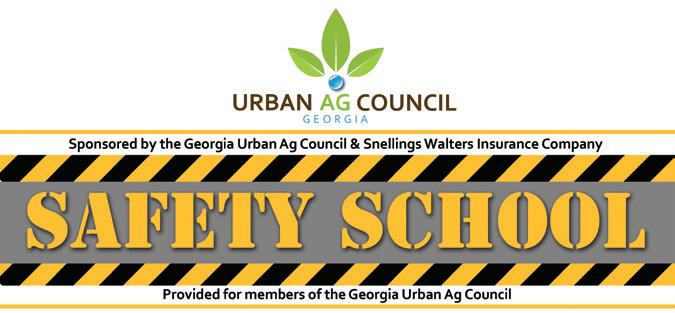
4 minute read
Safety works Preventing slips, trips and falls
UAC Safety School
Preventing slips, trips and falls
UAC’s Safety School provides everything you need to keep your employees informed of potential hazards. Below is the content from the Safety School training to prevent slips, trips and falls:
Objective
To point out the most common - and preventable - causes of serious injury and death related to slips, trips and falls.
Background
According to OSHA, slips, trips, and falls constitute the majority of general industry accidents. They cause 15 percent of all accidental deaths, and are second only to motor vehicles as a cause of fatalities.
Many causes
There are many situations that may cause slips, trips, and falls: ice, wet spots, grease, polished floors, loose flooring or carpeting, uneven walking surfaces, clutter, electrical cords, open desk drawers and filing cabinets, and damaged ladder steps. The controls needed to prevent these hazards are usually obvious but too often ignored, such as keeping walkways and stairs clear of scrap and debris; coiling up extension cords, lines, and hoses when not in use; keeping electrical and other wires out of the way; wearing lug soles in icy weather; clearing parking lots, stairs, and walkways in snowy weather; and using salt/sand as needed. The following different situations present unique slip, trip and fall hazards, so here are some tips to help control the exposures:
Housekeeping
• Keep designated walkways or paths clear of debris. • Do not block designated emergency exits. • Keep unused extension cords, hoses, or rope coiled up and out of the way. • Do not place or store equipment, tools, or material on steps or landings or below ladders. • Keep working area clean and organized. • Immediately clean any spill and place wet floor signs out if necessary. • Remove frayed or loose rugs or mats. • Install absorbent material around equipment that leaks.
Uneven walking surfaces
• Identify any change in elevation in shops with reflective tape or paint (anything greater than a ¼ inch should be clearly marked). • Remove any trip hazards in shop such as bolts or holes in the flooring. • Employees should wear above-the-ankle lace-up boots with a heavy lug sole when working in the field. Tennis shoes or pull-on style boots do offer the best protection for preventing slips or ankle sprains. • Step over or around obstructions, not on them. • Keep your hands at your sides, not in your pockets, for balance. • Walk, don’t run - and change directions slowly. • Pay attention to what you’re doing and where you are going. • Look out for broken concrete, manholes, uncovered drains and similar hazards. • Do not twist to turn when walking through ivy beds or other similar areas. • Watch out for slippery pine straw beds or slippery slopes.
Ladders
• Never carry equipment or other material when climbing up or down a ladder. Have another employee hand them to you or use a rope to raise and lower the material. • Always face the ladder and use a three point stance when climbing up or down. • Never over-reach when working from a ladder.
Climb down and move the ladder closer. • Make sure ladder is on stable ground. • Make sure your shoes and the rungs are free of mud, oil or grease. • NEVER stand on the top two rungs. • Have another employee hold the ladder or secure it by tying it off.
Stairs
• Keep stairs clear at all times: do not use stairs as storage areas. • Always use the hand railing. • Don’t carry anything that blocks your vision. • Keep stairs free from water, oil, grease, mud or anything else that might create a slip hazard.
Dovetail ramps
• Don’t jump off. Always use a three-point contact. • Walk slowly and avoid running. • Avoid walking on diamond plating, unless painted with an anti-skid paint. • Keep clear of debris and equipment if possible.
General tips to prevent slips, trips or falls:
• Stay away from the edges of loading docks, manholes, and similar places where falls could occur. • Use a ladder, not a box or chair, to reach high places. • Don’t jump from platforms. • Don’t carry or push loads that block your vision. • Identify all potential tripping and fall hazards before work starts. • Use a salt or other similar product to prevent ice build up on walkways. • Try to step flat footed and try not to place heel or toe down first.

FREE for all business-level UAC members!
Get this content and more in UAC’s online Safety School. Also included for each topic: > Review points, quiz and answer key > The companion powerpoint slide presentation > All available in both English and Spanish PLUS: > Attendance sheet to document training
Get the training
Visit UAC's Safety School to get training materials (training notes, slide presentation, attendance sheets) on a variety of safety topics.
UAC Safety School is available online to all businesslevel UAC members.
Here's how to access:
> Go to urbanagcouncil.com
> Use the "MEMBERSHIP" menu tab
> Click on "Members-only content" > Log in as a member > Use the email address and password that is associated with your UAC membership > Need help? Contact us: Call 706.750.0350 or email office@georgiauac.com > Scroll to the "Safety" category on that list and click on "Visit UAC Safety School"
UAC Safety School information is provided by the Georgia Urban Ag Council and Snellings Walters Insurance Agency and is intended for use by UAC member companies only.










